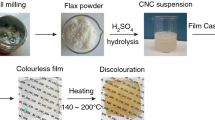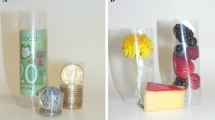Abstract
This study used raw and bleached cotton fibers from the textile carding process to obtain cellulose nanocrystals (CNCs) via acid hydrolysis. These materials were then used as nanofillers to improve the properties of films made of sodium alginate (ALG), carboxymethyl cellulose (CMC), and blends of ALG:CMC (1:1). The obtained materials were characterized based on their suspension stability (zeta potential), yield, thermal behavior, and crystallinity. The mechanical properties and water vapor permeability (WVP) of films with different CNC contents (1, 2.5 and 5 wt%) were analyzed. The results indicated that bleached cotton generated CNCs with a smaller size and higher yield than raw cotton. The CNCs extracted from bleached and raw cotton showed crystallinities 18% and 20% higher than the original materials, respectively, and the suspensions were stable. The incorporation of bleached CNCs increased the tensile strength of ALG films by 36% (at 5 wt%) and CMC films by 35% (at 2.5 wt%). The mechanical properties of the ALG:CMC films were not altered by adding CNCs. Raw and bleached CNCs reduced the WVP of the ALG films (up to 39%) and ALG:CMC films (32%). In general, the CNCs obtained from bleached cotton tended to act as the best reinforcing agent for ALG and CMC films, giving it the potential for use in food applications.





Similar content being viewed by others
References
Ahankari SS, Subhedar AR, Bhadauria SS, Dufresne A (2021) Nanocellulose in food packaging: a review. Carbohydr Polym. https://doi.org/10.1016/j.carbpol.2020.117479
Amara C, El Mahdi A, Medimagh R, Khwaldia K (2021) Nanocellulose-based composites for packaging applications. Curr Opin Green Sustain Chem. https://doi.org/10.1016/j.cogsc.2021.100512
Bangar SP, Whiteside WS (2021) Nano-cellulose reinforced starch bio composite films—a review on green composites. Int J Biol Macromol. https://doi.org/10.1016/j.ijbiomac.2021.07.017
Baranwal J, Barse B, Fais A, Delogu GL, Kumar A (2022) Biopolymer: a sustainable material for food and medical applications. Polymers. https://doi.org/10.3390/polym14050983
Bierhalz AC, Moraes ÂM (2016) Tuning the properties of alginate—chitosan membranes by varying the viscosity and the proportions of polymers. J Appl Polym Sci. https://doi.org/10.1002/app.44216
Chen X, Deng X, Shen W, Jiang L (2012) Controlled enzymolysis preparation of nanocrystalline cellulose from pretreated cotton fibers. BioResources 7:4237–4248
de Morais TE, Corrêa AC, Manzoli A, de Lima LF, de Oliveira CR, Mattoso LHC (2010) Cellulose nanofibers from white and naturally colored cotton fibers. Cellulose. https://doi.org/10.1007/s10570-010-9403-0
Deepa B, Abraham E, Pothan LA, Cordeiro N, Faria M, Thomas S (2016) Biodegradable nanocomposite films based on sodium alginate and cellulose nanofibrils. Materials. https://doi.org/10.3390/ma9010050
El Miri N, Aziz F, Aboulkas A, El Bouchti M, Ben Youcef H, El Achaby M (2018) Effect of plasticizers on physicochemical properties of cellulose nanocrystals filled alginate bionanocomposite films. Adv Polym Technol. https://doi.org/10.1002/adv.22087
Galiano F, Briceño K, Marino T, Molino A, Christensen KV, Figoli A (2018) Advances in biopolymer-based membrane preparation and applications. J Membr Sci. https://doi.org/10.1016/j.memsci.2018.07.059
Gordon S (2009) Identifying plant fibres in textiles: the case of cotton. In: Houck MM (ed) Identification of textile fibers. Woodhead Publishing, Cambridge, pp 239–258. https://doi.org/10.1533/9781845695651.3.239
Hong LG, Yuhana NY, Zawawi EZE (2021) Review of bioplastics as food packaging materials. AIMS Mater Sci. https://doi.org/10.3934/matersci.2021012
Huang S, Tao R, Ismail A, Wang Y (2020) Cellulose nanocrystals derived from textile waste through acid hydrolysis and oxidation as reinforcing agent of soy protein film. Polymers. https://doi.org/10.3390/polym12040958
Huang C, Yu H, Abdalkarim SYH, Li Y, Chen X, Yang X, Zhou Y, Zhang L (2022) A comprehensive investigation on cellulose nanocrystals with different crystal structures from cotton via an efficient route. Carbohydr Polym. https://doi.org/10.1016/j.carbpol.2021.118766
Huq T, Salmieri S, Khan A, Khan RA, Le Tien C, Riedl B, Fraschini C, Bouchard J, Uribe-Calderon J, Kamal MR, Lacroix M (2012) Nanocrystalline cellulose (NCC) reinforced alginate based biodegradable nanocomposite film. Carbohydr Polym. https://doi.org/10.1016/j.carbpol.2012.07.065
Huq T, Riedl B, Bouchard J, Salmieri S, Lacroix M (2014) Microencapsulation of nisin in alginate-cellulose nanocrystal (CNC) microbeads for prolonged efficacy against Listeria monocytogenes. Cellulose. https://doi.org/10.1007/s10570-014-0432-y
Lee KY, Mooney DJ (2012) Alginate: properties and biomedical applications. Prog Polym Sci. https://doi.org/10.1016/j.progpolymsci.2011.06.003
Lu P, Hsieh Y-L (2010) Preparation and properties of cellulose nanocrystals: rods, spheres, and network. Carbohydr Polym. https://doi.org/10.1016/j.carbpol.2010.04.073
Mandal A, Chakrabarty D (2019) Studies on mechanical, thermal, and barrier properties of carboxymethyl cellulose film highly filled with nanocellulose. J Thermoplast Compos Mater. https://doi.org/10.1177/0892705718772868
Mojsov K (2019) Enzymatic desizing, bioscouring and enzymatic bleaching of cotton fabric with glucose oxidase. J Text Inst. https://doi.org/10.1080/00405000.2018.1535240
Morais JPS, de Freitas Rosa M, Nascimento LD, do Nascimento DM, Cassales AR (2013) Extraction and characterization of nanocellulose structures from raw cotton linter. Carbohydr Polym. https://doi.org/10.1016/j.carbpol.2012.08.010
Moustafa H, Youssef AM, Darwish NA, Abou-Kandil AI (2019) Eco-friendly polymer composites for green packaging: future vision and challenges. Compos B Eng. https://doi.org/10.1016/j.compositesb.2019.05.048
Oun AA, Rhim JW (2015) Effect of post-treatments and concentration of cotton linter cellulose nanocrystals on the properties of agar-based nanocomposite films. Carbohydr Polym. https://doi.org/10.1016/j.carbpol.2015.07.053
Oun AA, Rhim JW (2016) Isolation of cellulose nanocrystals from grain straws and their use for the preparation of carboxymethyl cellulose-based nanocomposite films. Carbohydr Polym. https://doi.org/10.1016/j.carbpol.2016.05.020
Papageorgiou SK, Kouvelos EP, Favvas EP, Sapalidis AA, Romanos GE, Katsaros FK (2010) Metal–carboxylate interactions in metal–alginate complexes studied with FTIR spectroscopy. Carbohydr Res. https://doi.org/10.1016/j.carres.2009.12.010
Perumal AB, Nambiar RB, Sellamuthu PS, Sadiku ER, Li X, He Y (2022) Extraction of cellulose nanocrystals from areca waste and its application in eco-friendly biocomposite film. Chemosphere. https://doi.org/10.1016/j.chemosphere.2021.132084
Poonguzhali R, Khaleel Basha S, Sugantha Kumari V (2018) Synthesis of alginate/nanocellulose bionanocomposite for in vitro delivery of ampicillin. Polym Bull. https://doi.org/10.1007/s00289-017-2253-2
Rahman M, Hasan M, Nitai AS, Nam S, Karmakar AK, Ahsan M, Shiddiki MJA, Ahmed MB (2021) Recent developments of carboxymethyl cellulose. Polymers. https://doi.org/10.3390/polym13081345
Sanchez-Garcia MD, Gimenez E, Lagaron JM (2008) Morphology and barrier properties of solvent cast composites of thermoplastic biopolymers and purified cellulose fibers. Carbohydr Polym. https://doi.org/10.1016/j.carbpol.2007.05.041
Sanchez-Garcia MD, Lagaron JM (2010) On the use of plant cellulose nanowhiskers to enhance the barrier properties of polylactic acid. Cellulose. https://doi.org/10.1007/s10570-010-9430-x
Satyamurthy P, Jain P, Balasubramanya RH, Vigneshwaran N (2011) Preparation and characterization of cellulose nanowhiskers from cotton fibres by controlled microbial hydrolysis. Carbohydr Polym. https://doi.org/10.1016/j.carbpol.2010.07.029
Segal LGJMA, Creely JJ, Martin AE Jr, Conrad CM (1959) An empirical method for estimating the degree of crystallinity of native cellulose using the X-ray diffractometer. Tex Res J. https://doi.org/10.1177/004051755902901003
Shamskar KR, Heidari H, Rashidi A (2016) Preparation and evaluation of nanocrystalline cellulose aerogels from raw cotton and cotton stalk. Ind Crops Prod. https://doi.org/10.1016/j.indcrop.2016.01.044
Silva SS, Rodrigues LC, Fernandes EM, Reis RL (2020) Fundamentals on biopolymers and global demand. In: Moraes MA, Silva CF, Vieira RS (eds) Biopolymer membranes and films: health, food, environment, and energy applications. Elsevier, Amsterdam, pp 3–34
Thambiraj S, Shankaran DR (2017) Preparation and physicochemical characterization of cellulose nanocrystals from industrial waste cotton. Appl Surf Sci. https://doi.org/10.1016/j.apsusc.2017.03.272
Tian Y, Zhu P, Zhou M, Lin Y, Cheng F (2020) Effect of microfibrillated cellulose loading on physical properties of starch/polyvinyl alcohol composite films. J Wuhan Univ Technol Mat Sci Edit. https://doi.org/10.1007/s11595-020-2326-1
Trache D, Hussin MH, Haafiz MM, Thakur VK (2017) Recent progress in cellulose nanocrystals: sources and production. Nanoscale. https://doi.org/10.1039/C6NR09494E
Trevisol TC, Fritz ARM, de Souza SMAGU, Bierhalz ACK, Valle JAB (2019) Alginate and carboxymethyl cellulose in monolayer and bilayer films as wound dressings: effect of the polymer ratio. J Appl Polym Sci. https://doi.org/10.1002/app.46941
Topalovic T, Nierstrasz VA, Bautista L, Jocic D, Navarro A, Warmoeskerken MM (2007) Analysis of the effects of catalytic bleaching on cotton. Cellulose. https://doi.org/10.1007/s10570-007-9120-5
Wang LF, Shankar S, Rhim JW (2017) Properties of alginate-based films reinforced with cellulose fibers and cellulose nanowhiskers isolated from mulberry pulp. Food Hydrocoll. https://doi.org/10.1016/j.foodhyd.2016.08.041
Wang Z, Yao Z, Zhou J, He M, Jiang Q, Li A, Li S, Liu M, Zhang D (2019) Improvement of polylactic acid film properties through the addition of cellulose nanocrystals isolated from waste cotton cloth. Int J Biol Macromol. https://doi.org/10.1016/j.ijbiomac.2019.02.021
Yadav M, Chiu FC (2019) Cellulose nanocrystals reinforced κ-carrageenan based UV resistant transparent bionanocomposite films for sustainable packaging applications. Carbohydr Polym. https://doi.org/10.1016/j.carbpol.2019.01.114
Yadav M, Liu YK, Chiu FC (2019) Fabrication of cellulose nanocrystal/silver/alginate bio nanocomposite films with enhanced mechanical and barrier properties for food packaging application. Nanomaterials. https://doi.org/10.3390/nano9111523
Acknowledgments
The authors thank the the Coordenação de Aperfeiçoamento de Pessoal de Nível Superior—Brasil (CAPES)—Finance Code 001 and the Conselho Nacional de Desenvolvimento Científico e Tecnológico (CNPq) (Grant number 438821/2018-1) for financial support; the LINDEN-Metro Laboratory and Central de Análises of the Federal University of Santa Catarina.
Funding
This work was supported by Conselho Nacional de Desenvolvimento Científico e Tecnológico (CNPq) (Grant number 438821/2018-1) and by the Coordenação de Aperfeiçoamento de Pessoal de Nível Superior—Brasil (CAPES)—Finance Code 001.
Author information
Authors and Affiliations
Corresponding author
Ethics declarations
Competing interest
The authors have no relevant financial or non-financial interests to disclose.
Additional information
Publisher's Note
Springer Nature remains neutral with regard to jurisdictional claims in published maps and institutional affiliations.
Rights and permissions
Springer Nature or its licensor (e.g. a society or other partner) holds exclusive rights to this article under a publishing agreement with the author(s) or other rightsholder(s); author self-archiving of the accepted manuscript version of this article is solely governed by the terms of such publishing agreement and applicable law.
About this article
Cite this article
Mari, R.P., Sornas, J.J. & Bierhalz, A.C.K. Polysaccharide-based films reinforced with nanocellulose isolated from raw and bleached cotton. Cellulose 30, 1657–1668 (2023). https://doi.org/10.1007/s10570-022-04980-1
Received:
Accepted:
Published:
Issue Date:
DOI: https://doi.org/10.1007/s10570-022-04980-1




